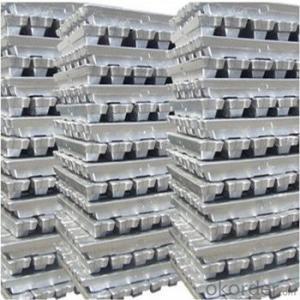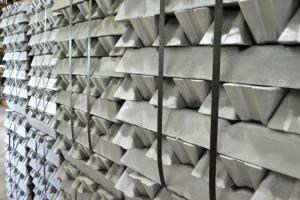Aluminium Ingot 99.7% National Standard Pure
- Loading Port:
- China main port
- Payment Terms:
- TT OR LC
- Min Order Qty:
- 1000 m.t.
- Supply Capability:
- 10000 m.t./month
OKorder Service Pledge
OKorder Financial Service
You Might Also Like
Pure Aluminum Ingot Used for Industry
1.Structure of Aluminum Ingot Description
A material that has been cast into a shape in order to be transported and processed easier than in an unprocessed form. An ingot is typically rectangular in shape, which allows it to be stacked. Ingots are most commonly associated with metals, with ingots of gold held in the vaults of banks and brokerages being popular images.
2.Main Features of the Aluminum Ingot
•High Purity
•High strength
•Fast melting
•Best price
•Good after-service
3. Aluminum Ingot Images


4. Aluminum Ingot Specification
Grade | Chemical Composition % | |||||||||
Al≥ | impurities ≤ | |||||||||
Si | Fe | Cu | Ga | Mg | Zn | Mn | others | Sum | ||
Al99.9 | 99.90 | 0.50 | 0.07 | 0.005 | 0.02 | 0.01 | 0.025 | - | 0.010 | 0.10 |
Al99.85 | 99.85 | 0.80 | 0.12 | 0.005 | 0.03 | 0.02 | 0.030 | - | 0.015 | 0.15 |
Al99.7 | 99.70 | 0.10 | 0.20 | 0.010 | 0.03 | 0.02 | 0.030 | - | 0.030 | 0.30 |
Al99.6 | 99.60 | 0.16 | 0.25 | 0.010 | 0.03 | 0.03 | 0.030 | - | 0.030 | 0.40 |
Al99.5 | 99.50 | 0.22 | 0.30 | 0.020 | 0.03 | 0.05 | 0.050 | - | 0.030 | 0.50 |
Al99.00 | 99.00 | 0.42 | 0.50 | 0.020 | 0.03 | 0.05 | 0.050 | - | 0.050 | 1.00 |
5.FAQ of Aluminum Ingot
We have organized several common questions for our clients,may help you sincerely:
①How about your company?
A world class manufacturer & supplier of castings forging in carbon steel and alloy steel,is one of the large-scale professional investment casting production bases in China,consisting of both casting foundry forging and machining factory. Annually more than 8000 tons Precision casting and forging parts are exported to markets in Europe,America and Japan. OEM casting and forging service available according to customer’s requirements.
②How to guarantee the quality of the products?
We have established the international advanced quality management system,every link from raw material to final product we have strict quality test;We resolutely put an end to unqualified products flowing into the market. At the same time, we will provide necessary follow-up service assurance.
③How long can we receive the product after purchase?
In the purchase of product within three working days, We will arrange the factory delivery as soon as possible. The pecific time of receiving is related to the state and position of customers.Commonly 7 to 10 working days can be served.
- Q: How are aluminum ingots stored and transported?
- Aluminum ingots are typically stored and transported in a careful and systematic manner to ensure their safety and quality. Firstly, ingots are usually stored in warehouses or storage facilities specifically designed for handling metals. These facilities are equipped with adequate ventilation, temperature control, and protection against moisture to prevent any damage or contamination. To store aluminum ingots, they are typically stacked on pallets or placed in racks, depending on the size and weight of the ingots. The ingots are arranged in a way that allows for easy access and ensures stability during storage. In some cases, ingots may be individually wrapped or covered with protective materials to prevent scratching or surface damage. When it comes to transportation, aluminum ingots are usually moved using various methods depending on the distance and quantity. For shorter distances, smaller quantities of ingots can be transported using forklifts or hand trucks. In these cases, it is important to secure the ingots properly to prevent any movement or potential falling during transport. For longer distances, larger quantities of aluminum ingots are typically transported by trucks, trains, or ships. These transportation methods often require specialized containers or trailers designed to hold the ingots securely and protect them from external factors. In some cases, ingots may be loaded into shipping containers or placed on flatbed trailers. It is crucial to ensure proper handling and securing of aluminum ingots during transportation to minimize the risk of damage or accidents. The transportation containers or vehicles should have appropriate padding or cushioning to absorb any potential shocks or vibrations that could potentially impact the ingots. Overall, the storage and transportation of aluminum ingots involve careful planning, adherence to safety protocols, and the use of specialized equipment to maintain their quality and integrity throughout the process.
- Q: Can aluminum ingots be used in the production of musical instruments?
- Yes, aluminum ingots can be used in the production of musical instruments. Aluminum is a lightweight and durable metal that can be molded into various shapes, making it suitable for the construction of instrument bodies, parts, and accessories.
- Q: How are aluminum ingots used in the production of building facades?
- The production of building facades heavily relies on the essential properties and versatility of aluminum ingots. These ingots enable the creation of lightweight, durable, and aesthetically pleasing facades in modern architecture. To begin, aluminum ingots are melted and cast into various shapes and sizes according to the specific design requirements of the building facade. This casting process ensures that the aluminum can be easily manipulated and fabricated into different facade components. Once cast, the ingots can be extruded or rolled into sheets, panels, or profiles. These aluminum sheets or panels are then cut, shaped, and assembled to achieve the desired facade design. The malleability of aluminum allows for intricate designs and customization options, enabling architects to bring their creative visions to life. One of the major advantages of aluminum ingots in building facades is their lightweight nature. With a low density, aluminum is significantly lighter than other metals like steel. This characteristic reduces the overall weight of the facade, making installation easier and decreasing the load on the building structure. Moreover, the lightweight property of aluminum facilitates the creation of larger and more expansive facade designs, opening up greater design possibilities. Furthermore, aluminum ingots possess excellent corrosion resistance, a crucial attribute for building facades exposed to different weather conditions. The natural oxide layer that forms on the surface of aluminum protects it from rust and corrosion, ensuring the facade's longevity and durability. This resistance to corrosion reduces maintenance costs and extends the lifespan of the building facade. Additionally, aluminum ingots offer high thermal conductivity, which plays a significant role in effective thermal management for building facades. By helping regulate temperature and reducing energy consumption, aluminum facades contribute to sustainable building practices. These facades can also incorporate insulation materials to enhance energy efficiency. In terms of aesthetics, aluminum ingots provide a wide range of finishing options. They can be anodized, painted, or coated in various colors and textures to achieve the desired appearance. Aluminum facades can also be combined with other materials like glass or stone to create visually striking and modern facades that enhance the overall architectural design. In conclusion, the extensive use of aluminum ingots in building facades is due to their lightweight nature, corrosion resistance, thermal conductivity, and design versatility. These properties empower architects and designers to create durable, energy-efficient, and visually appealing facades that align with modern architectural trends.
- Q: Can you melt the aluminium ingot?
- Cans and cans and rings are aluminium alloys with different compositions. The tank is made of aluminium alloy coil and punched out each plate first, and then the wafer is deep washed into a tank.
- Q: Cost of material consumption of aluminium ingot
- Production cost refers to the total amount of material goods and remuneration paid by an enterprise to produce a certain amount of a commodity, that is, the C+V part in the composition of commodity value.
- Q: Can the art knife cut the aluminum ingot?
- I've been working at the art tool maker for so long. I don't seem to have heard much about cutting aluminum ingots with art knives
- Q: 102 non-standard aluminum ingot is like? And ordinary non-standard aluminum ingot what is the difference?
- Ordinary non-standard aluminum ingot is the tube you use, regardless of your standard, with miscellaneous aluminum recovery smelting out of the aluminum ingot.
- Q: Casting aluminum ingot, environmental protection has those requirements?.
- The air cooler and pulse bag filter system are all negative pressure systems, and the draft fan is placed behind the dust removal system. Calcium carbide furnace, furnace, ferrosilicon furnace flue gas first enters the air cooler, the air cooler cooling, cooling to the full temperature range of bag filter can bear, enter into the bag pulse dust collector, after the dust of the flue gas from the chimney fan discharge, discharge from the dust hopper.
- Q: What are the different alloying elements used in aluminum ingots?
- The different alloying elements used in aluminum ingots include copper, magnesium, manganese, silicon, and zinc.
- Q: It can be dissolved aluminum cans, aluminum ingots, need what equipment?
- A lot of cans are iron, not much aluminum.
Send your message to us
Aluminium Ingot 99.7% National Standard Pure
- Loading Port:
- China main port
- Payment Terms:
- TT OR LC
- Min Order Qty:
- 1000 m.t.
- Supply Capability:
- 10000 m.t./month
OKorder Service Pledge
OKorder Financial Service
Similar products
Hot products
Hot Searches
Related keywords




























